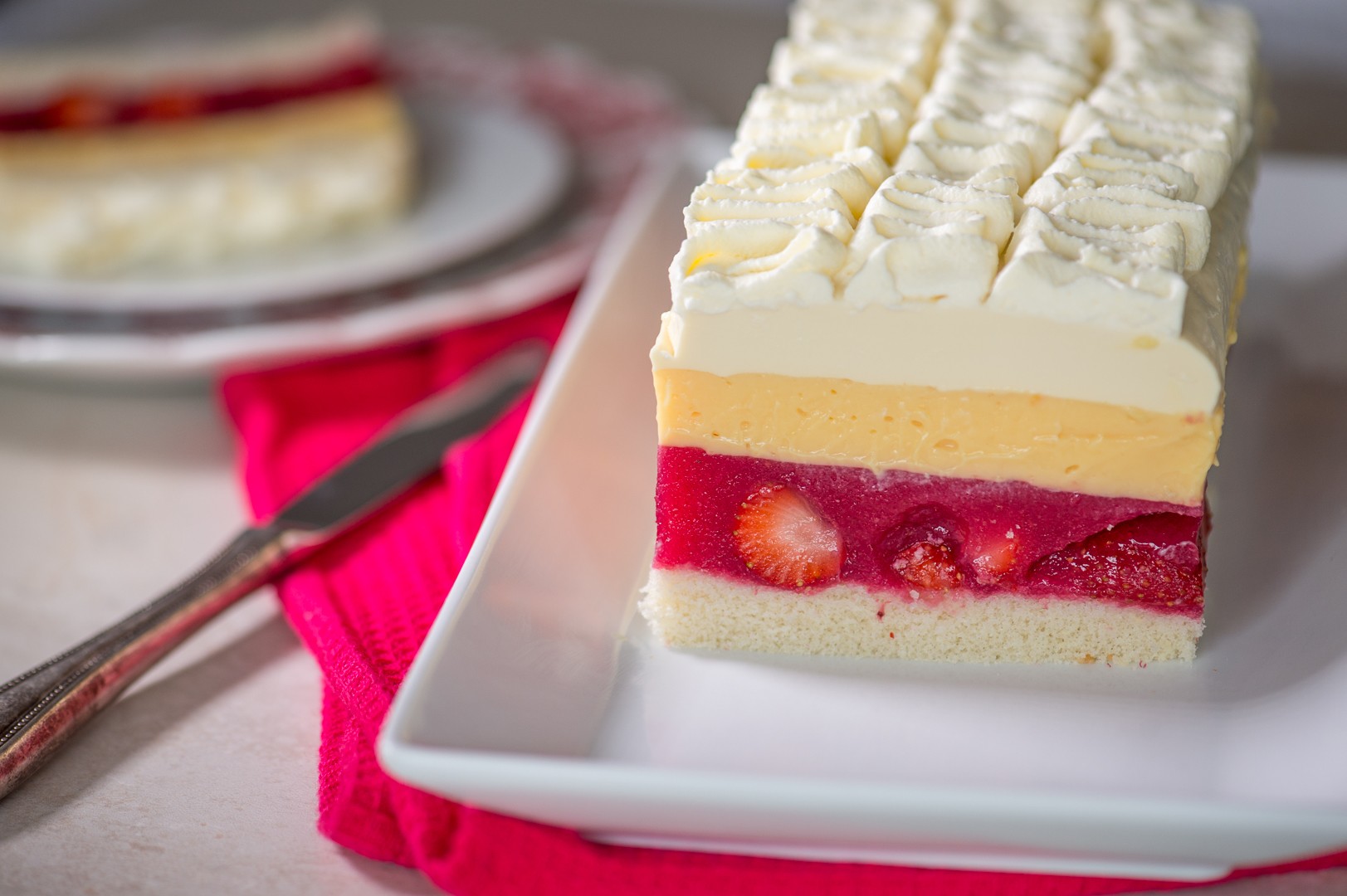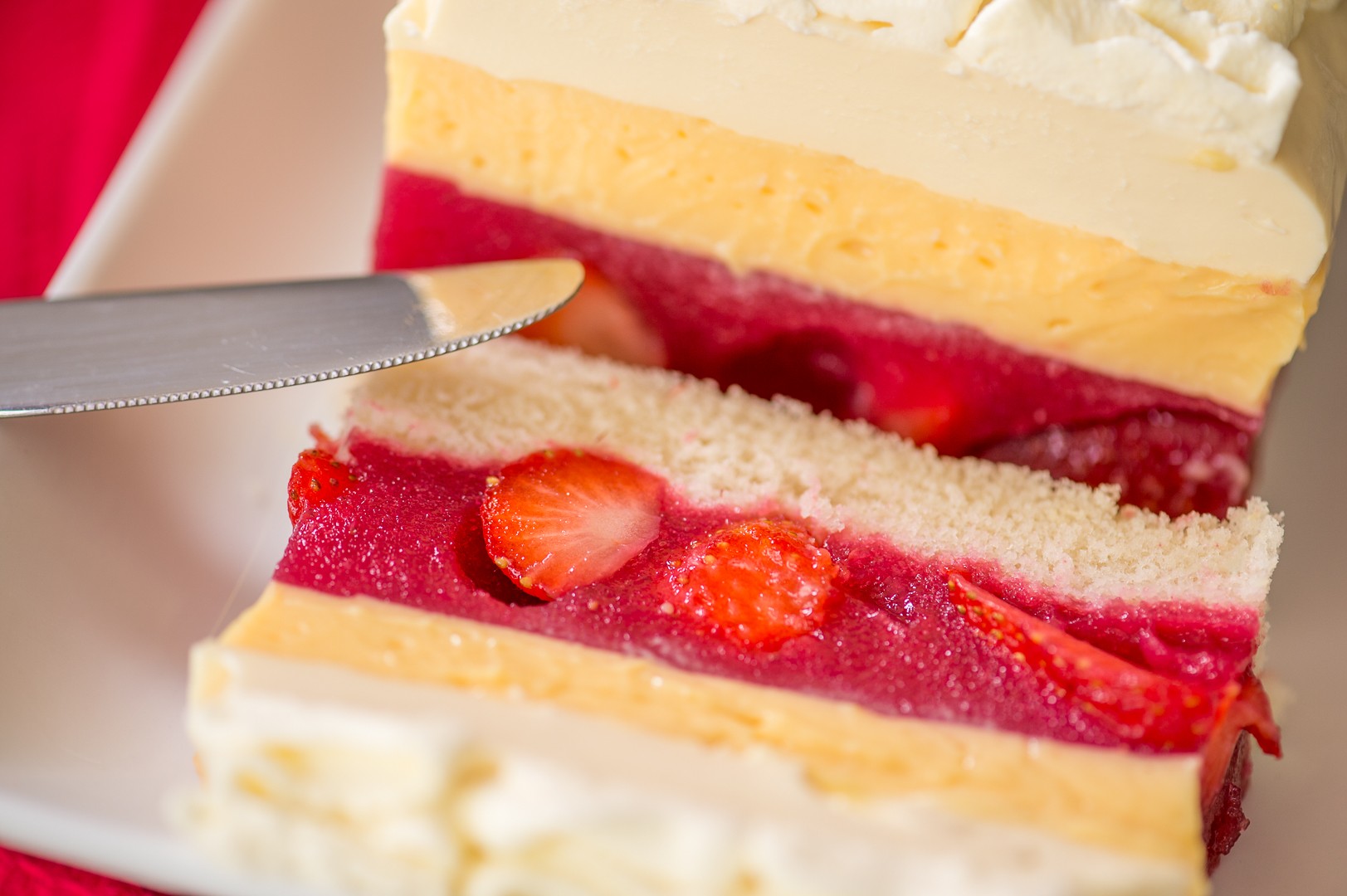
22 Dec Trifle Slice
There appears to have been somewhat of a “trifle revival” taking place this year. Magazines, foodie programs and instagram all seem to be flooded with images of this retro dessert. As I always say, there is a reason classic dishes such as trifle have stood the test of time! The combination of cake, jelly, fruit, custard and cream is a definite winner. Let’s be honest though, when serving it up it can look a little… sloppy. This updated version of the classic trifle (inspired by a BBC Food recipe) transforms it into a sophisticated Trifle Slice. It’s a neater, more glamourous version that retains all the luscious flavours and textures of a traditional trifle.

Ingredients:
For the cream layer
2 gelatine leaves
200ml cream
3 tbsp sherry or cream liqueur eg Cape Velvet or Amarula
100g marscapone
3 tbsp icing sugar
For the custard layer
350ml full cream milk
85g castor sugar
3 egg yolks
20g cornflour
20g custard powder
5ml vanilla extract
For the strawberry jelly layer
6 gelatine leaves
500g strawberries
100ml water
70g castor sugar
For the sponge layer
1 x shop-bought vanilla sponge cake
To decorate
200ml cream
2 tsp icing sugar
Directions:
- Lightly grease a loaf tin and then line with clingfilm, pushing the clingfilm down as smoothly as possible. Leave some extra clingfilm hanging over the sides of the tin.
- For the cream layer, cover the gelatine leaves with cold water and set aside to soak.
- Add the cream and sherry/liqueur to a small saucepan and heat together on low heat, stirring occasionally until hot but not boiling. Squeeze the excess water from the gelatine and whisk into the cream until completely dissolved.
- Whisk in the marscapone and icing sugar and mix until smooth. Pour into the lined loaf tin and refrigerate until set, about 1 hour.
- Meanwhile make the custard. Heat 300ml milk in a small saucepan until just boiling. Add the remaining 50ml milk together with the castor sugar, cornflour and custard powder to a bowl. Mix well then whisk in the egg yolks until smooth and creamy.
- Pour the hot milk into the egg mixture in a steady steam, whisking constantly, then add the whole lot back to the saucepan. Cook over a medium heat, stirring constantly, until the mixture comes to a boil and thickens. Remove from the heat and whisk in the vanilla extract until smooth. Cover with clingfilm (directly touching the surface of the custard) and leave to cool completly at room temperature.
- Once the cream layer has set and the custard is cool, pipe or spoon the custard layer onto the cream layer and spread evenly. Refrigerate until set, about 1 hour.
- While the custard is setting, make the jelly layer. Soak the gelatine leaves in cold water until softened. Hull and chop up 350g of strawberries and place in a saucepan with the sugar and water. Stir until the sugar has melted, the bring to the boil and simmer for about 5 minutes until the strawberries become soft.
- Blitz the strawberry mixture with a hand blender until smooth, then pour the mixture through a sieve into a jug to remove any seeds. Squeeze the excess water from the gelatine leaves and stir into the strawberry mixture until dissolved. Leave to cool at room temperaure, stirring often to prevent it setting around the edges of the jug.
- Hull and halve the remaining 150g of strawberries. Carefully pour the cooled jelly mixture over the custard, then evenly sprinkle the halved straberries over the liquid. Place in the fridge for about an hour.
- Slice the vanilla sponge into a rectangle to fit your loaf tin. It should be about 1,5cm thick. You may need to cut out and patchwork 2 – 3 pieces together. When the jelly is no longer liquid, but not quite set, place the sponge layer on top and press down gently. Wrap up the trifle with the extra clingfilm hanging down the outside of the tin and refrigerate overnight.
- When you are ready to serve, unwrap the top bit of clingfilm then unmould the trifle onto a serving platter. Remove the remaining clingfilm, and trim the edges neatly if desired.
- Whip the cream and icing sugar together until the cream is stiff. Place into a piping bag and decorate the trifle as desired. I used a petal nozzle to create ruffles.



No Comments